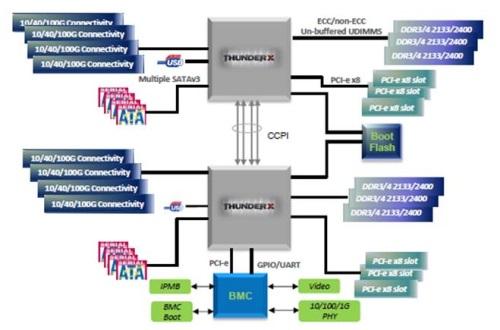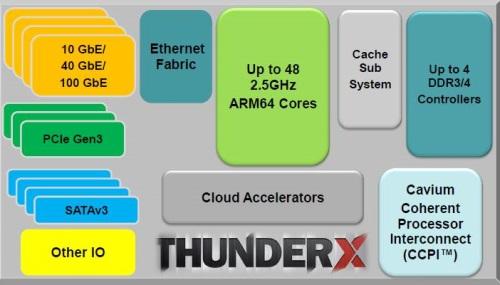Wednesday, June 04, 2014 4:38:27 AM
http://www.eetimes.com/document.asp?doc_id=1322565


Cavium plans four families of Thunder chips, targeting storage, networking, and security systems in addition to servers. Each family will use a different set of I/O and accelerator blocks from Cavium's existing silicon library.
The company plans to roll out high-end versions from all four groups initially. It aims to round out the portfolios three to six months later with 8 to 16 core versions.
The initial server SoCs will support DDR4 and integrate PCI Express Gen 3 x4 and x8 links. The server SoCs likely will pack just one or two 10G Ethernet controllers initially, with four-port 10G and 40G versions coming a year later.
Cavium will use the latest extensions of ARM's 64-bit V8 architecture, including a new exception handler (GICv3) and virtualization spec (SMMUv2). Each custom core handles out-of-order processing of up to three instructions per cycle and has a 16 Mbyte L2 cache.
In 2011 Applied Micro was the first to announce plans for a custom 64-bit ARM core. More recently AMD said it will design one, too, although it will not ship in SoCs until 2016.
Starting next year, Cavium will have a full line of ARM- and MIPS-based chips with a fair amount of overlap in the versions targeting networking systems.
"The way we see it, Thunder is more focused on cloud and data center systems and [the MIPS-based] Octeon is more embedded," says Raghib Hussain, one of Cavium's founders and its chief technology officer.
The two product lines use the same on- and off-chip interconnects, coherency protocols, and other silicon blocks. "As a result, we have the flexibility to pick and choose on a product-by-product basis whether to put in a MIPS or ARM core," says Hussain.
Nevertheless, the company now has to design two types of custom cores. "The long-term future depends on how the market evolves, but for the next generation we are committed to both" MIPS and ARM, he told us.
"I think we will see Thunder in embedded apps as well as servers," says analyst Gwennap, "so the question is over time what percent of sales will be on Thunder vs. Octeon -- over time they could shift more completely to the ARM side.
"The same thing is happening at Freescale and Broadcom -- all the major embedded guys are moving toward ARM," at the expense of MIPS and PowerPC.
— Rick Merritt, Silicon Valley Bureau Chief, EE Times
Recent INTC News
- Intel Corporation to Participate in Upcoming Investor Conferences • Business Wire • 05/16/2024 08:30:00 PM
- Walmart Corporate Job Cuts and Office Centralization, GameStop and AMC Surge, and More News • IH Market News • 05/14/2024 11:26:02 AM
- Kevin O’Buckley to Lead Foundry Services at Intel • Business Wire • 05/13/2024 02:15:00 PM
- Form 4 - Statement of changes in beneficial ownership of securities • Edgar (US Regulatory) • 05/10/2024 08:26:31 PM
- Form 4 - Statement of changes in beneficial ownership of securities • Edgar (US Regulatory) • 05/10/2024 08:25:27 PM
- Form 4 - Statement of changes in beneficial ownership of securities • Edgar (US Regulatory) • 05/10/2024 08:24:27 PM
- Form 4 - Statement of changes in beneficial ownership of securities • Edgar (US Regulatory) • 05/10/2024 08:22:59 PM
- Form 4 - Statement of changes in beneficial ownership of securities • Edgar (US Regulatory) • 05/10/2024 08:21:59 PM
- Form 4 - Statement of changes in beneficial ownership of securities • Edgar (US Regulatory) • 05/10/2024 08:20:54 PM
- Form 4 - Statement of changes in beneficial ownership of securities • Edgar (US Regulatory) • 05/10/2024 08:19:57 PM
- Form 4 - Statement of changes in beneficial ownership of securities • Edgar (US Regulatory) • 05/10/2024 08:18:57 PM
- Form 4 - Statement of changes in beneficial ownership of securities • Edgar (US Regulatory) • 05/10/2024 08:18:03 PM
- Form 4 - Statement of changes in beneficial ownership of securities • Edgar (US Regulatory) • 05/10/2024 08:16:49 PM
- Form 4 - Statement of changes in beneficial ownership of securities • Edgar (US Regulatory) • 05/10/2024 08:15:43 PM
- Form 4 - Statement of changes in beneficial ownership of securities • Edgar (US Regulatory) • 05/10/2024 08:14:28 PM
- JFrog and Akamai Drop Over 10% Despite Strong Profits; Sweetgreen, Array, SoundHound Surge, and More in Earnings • IH Market News • 05/10/2024 11:58:39 AM
- Form 8-K - Current report • Edgar (US Regulatory) • 05/09/2024 09:13:47 PM
- Form 4 - Statement of changes in beneficial ownership of securities • Edgar (US Regulatory) • 05/09/2024 08:21:56 PM
- Form 4 - Statement of changes in beneficial ownership of securities • Edgar (US Regulatory) • 05/09/2024 08:20:46 PM
- Form 4 - Statement of changes in beneficial ownership of securities • Edgar (US Regulatory) • 05/09/2024 08:19:13 PM
- Form 4 - Statement of changes in beneficial ownership of securities • Edgar (US Regulatory) • 05/09/2024 08:18:01 PM
- Form 4 - Statement of changes in beneficial ownership of securities • Edgar (US Regulatory) • 05/09/2024 08:16:49 PM
- Form 4 - Statement of changes in beneficial ownership of securities • Edgar (US Regulatory) • 05/09/2024 08:15:34 PM
- Form 4 - Statement of changes in beneficial ownership of securities • Edgar (US Regulatory) • 05/09/2024 08:14:08 PM
- Form 4 - Statement of changes in beneficial ownership of securities • Edgar (US Regulatory) • 05/09/2024 08:12:49 PM
North Bay Resources Reports Assays up to >25% Mg, 0.1% Ni, 0.1% Cu, 0.01% Co, 0.3 ppm Pt at Tulameen Platinum Project, British Columbia • NBRI • May 29, 2024 9:03 AM
One World Products, Inc. Issues Shareholder Update • OWPC • May 29, 2024 8:20 AM
Green Leaf Innovations, Inc. Engages Olayinka Oyebola & Co for Two-Year Audit • GRLF • May 28, 2024 8:30 AM
HealthLynked Introduces AI-Powered Chat Function to Enhance Healthcare Accessibility • HLYK • May 28, 2024 8:00 AM
Avant Technologies Engages Wired4Tech to Evaluate the Performance of Next Generation AI Server Technology • AVAI • May 23, 2024 8:00 AM
Branded Legacy, Inc. Unveils Collaboration with Celebrity Tattoo Artist Kat Tat for New Tattoo Aftercare Product • BLEG • May 22, 2024 8:30 AM









